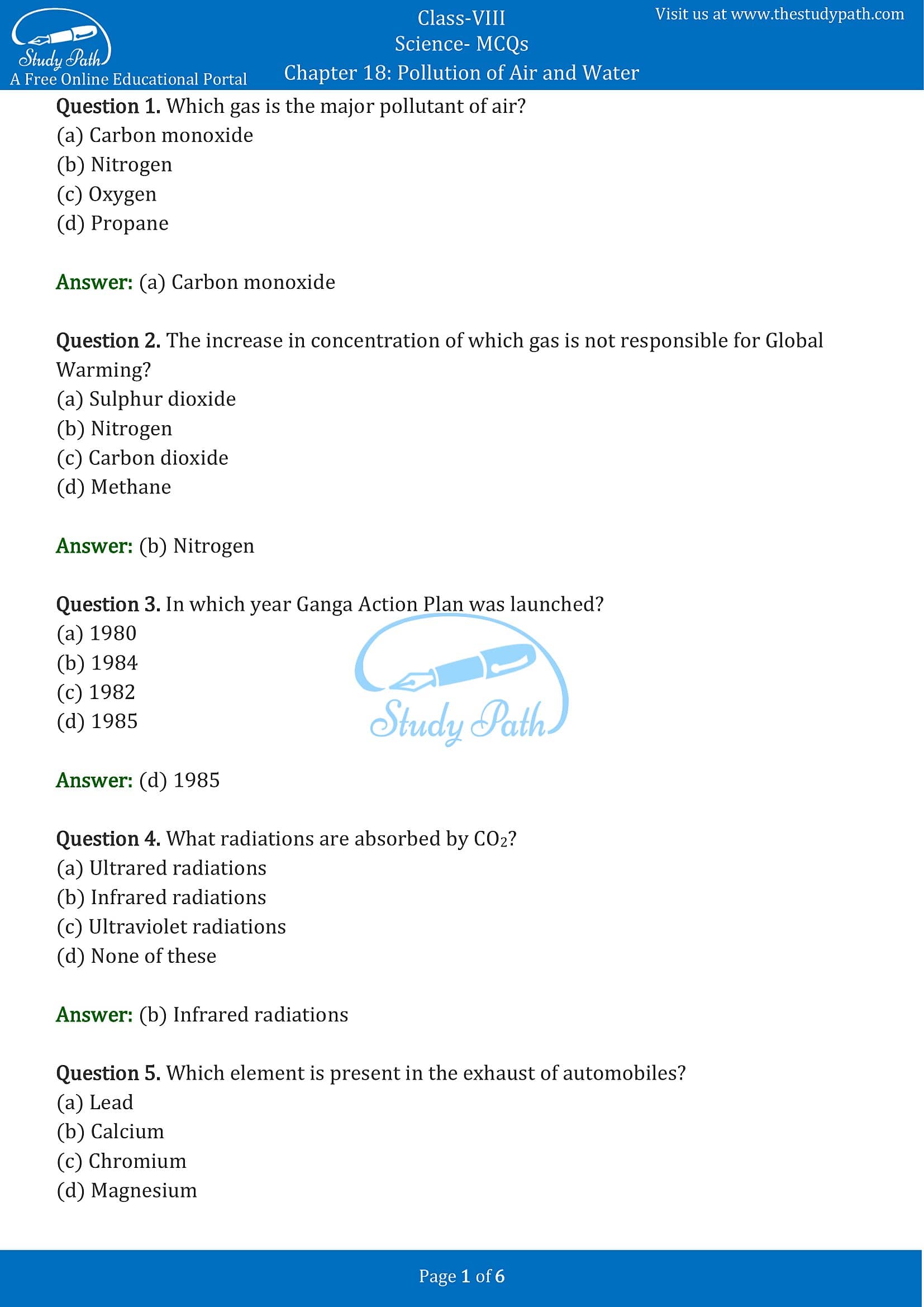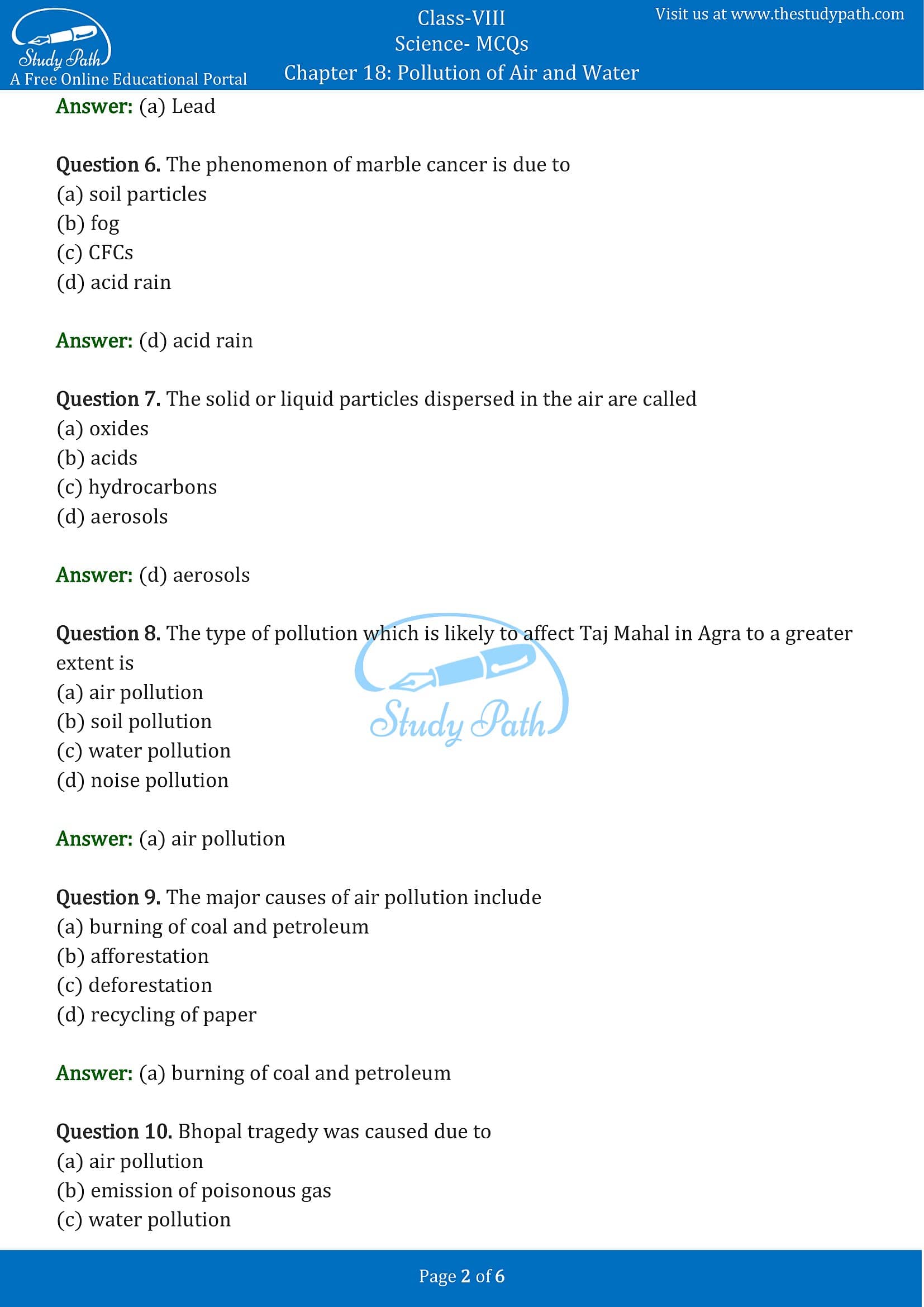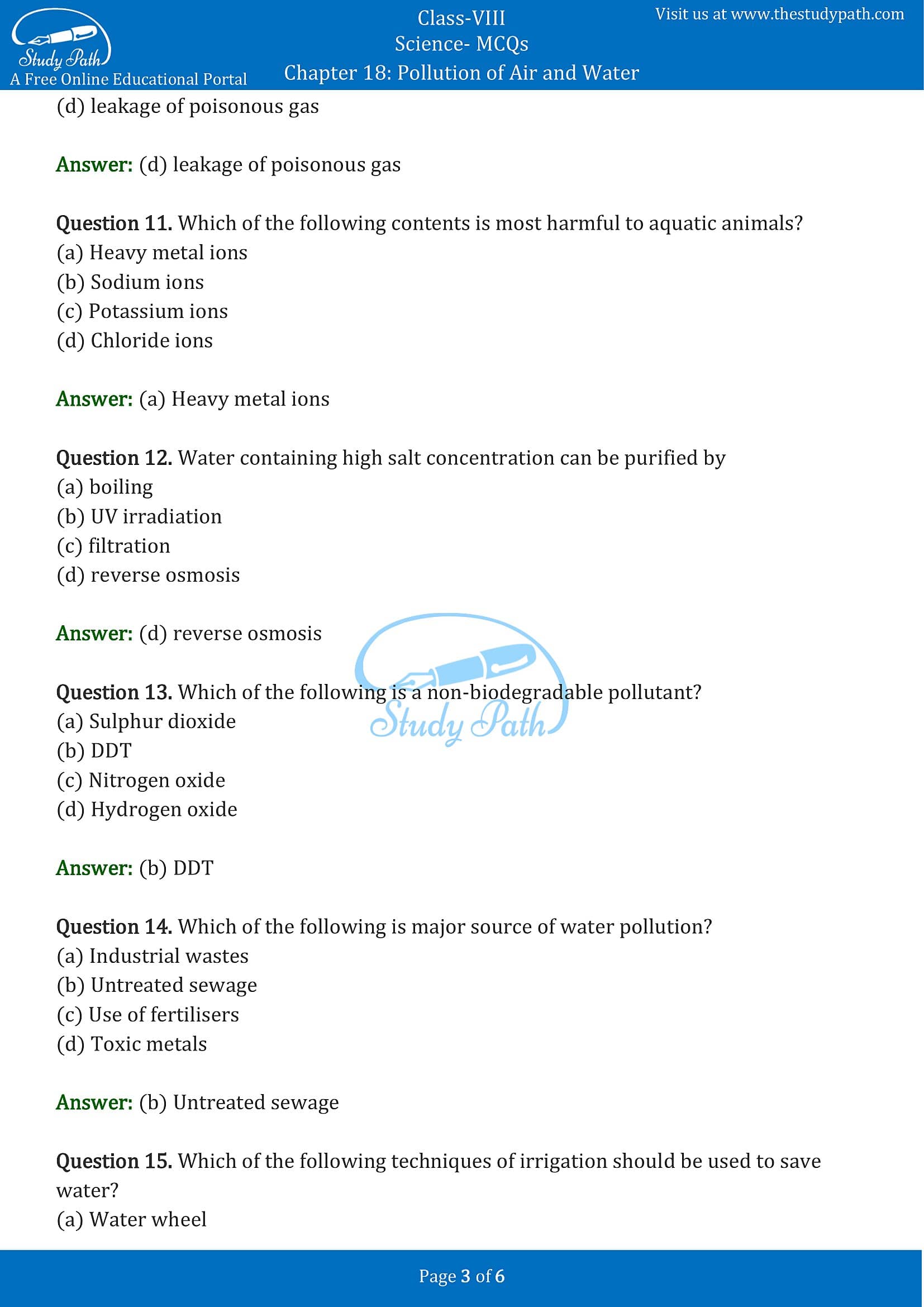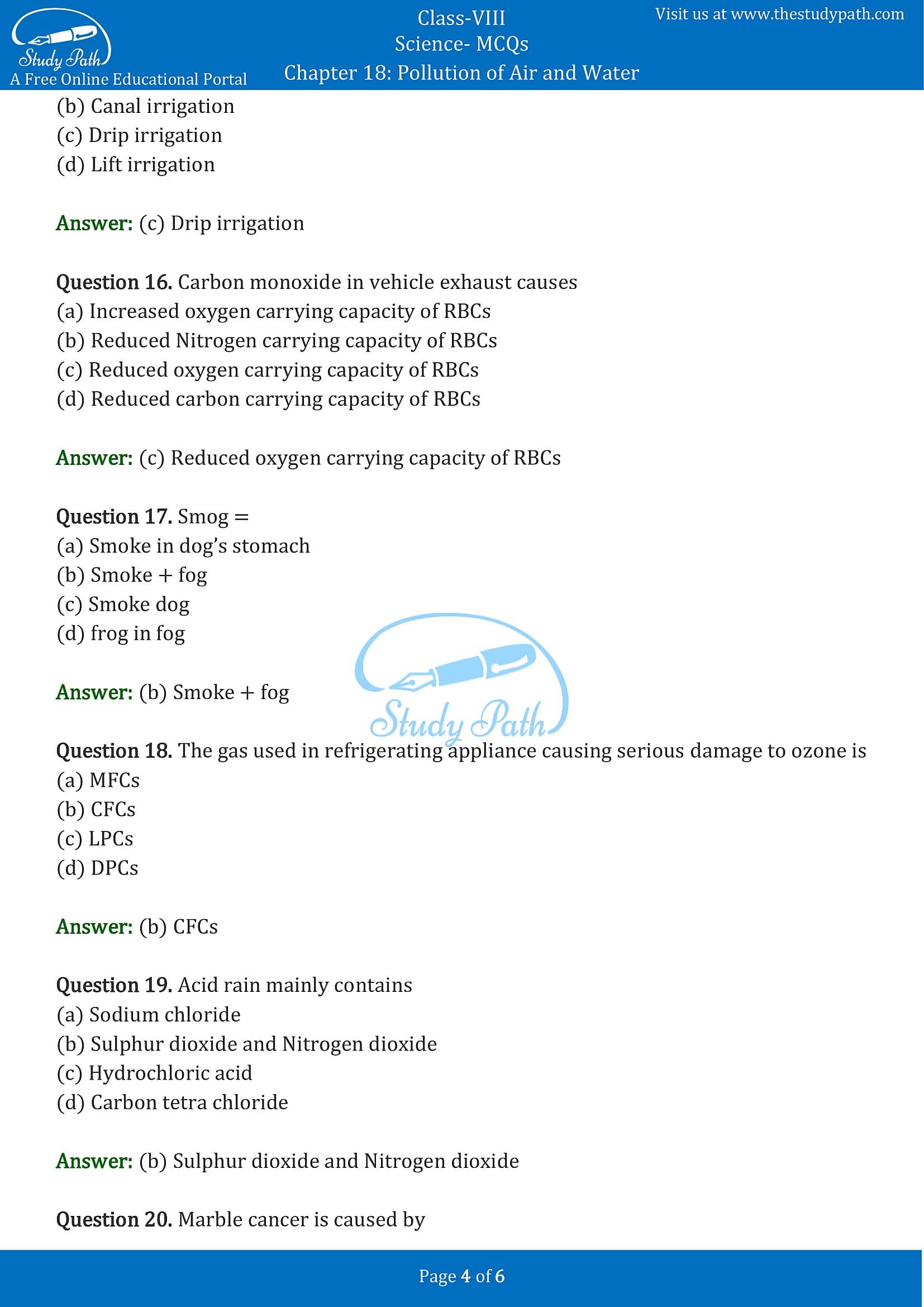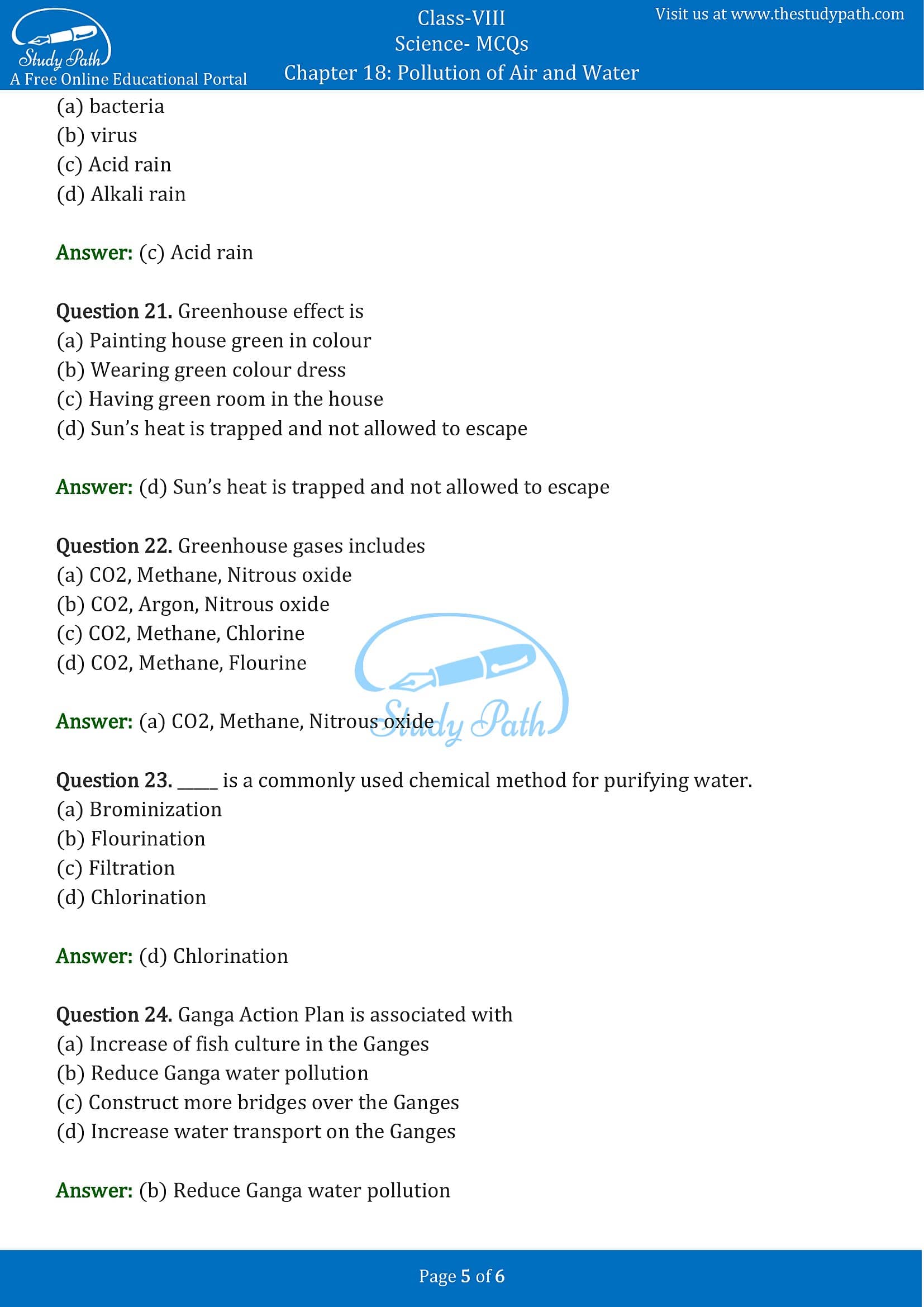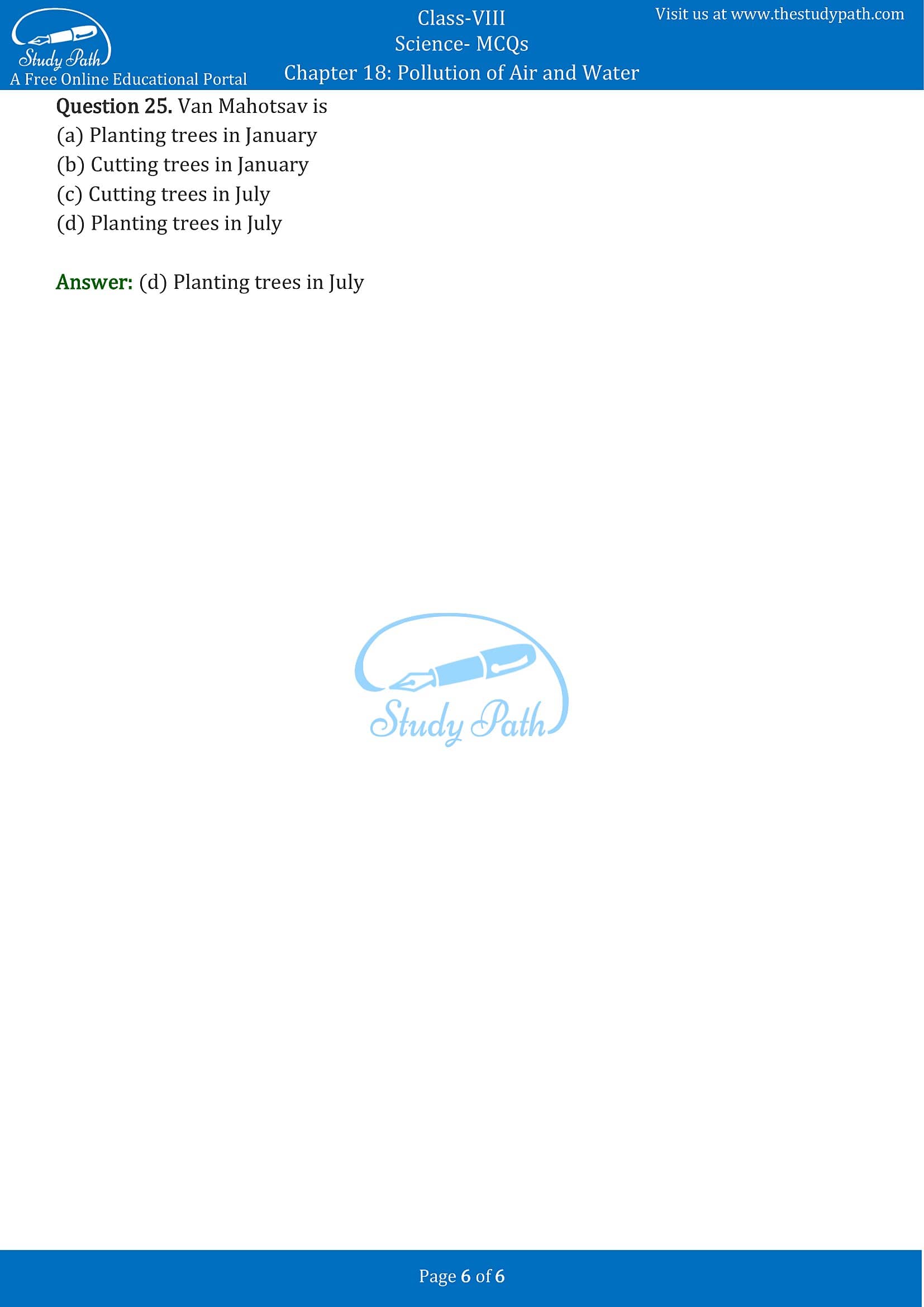Class 8 Science Chapter 18 Pollution of Air and Water MCQ with Answers
Class 8 Science Chapter 18 Pollution of Air and Water MCQ (Multiple Choice Questions) with Answers is available here in PDF format. CBSE Class 8 Science Pollution of Air and Water Objective Questions helps the students to understand the concepts thoroughly and to score good marks. Practising these MCQs will help you to answer every question that is being asked in the exams.
At Study Path, you can download PDF of Multiple Choice Questions for Class 8 Chapter 18 Pollution of Air and Water with Answers. We prepared these MCQs on the basis latest exam Pattern. Students can solve NCERT Class 8 Science Pollution of Air and Water MCQs before the exam to know their preparation level.
Pollution of Air and Water Class 8 MCQ with Answers
Multiple Choice Questions (MCQs)
Question 1. Which gas is the major pollutant of air?
(a) Carbon monoxide
(b) Nitrogen
(c) Oxygen
(d) Propane
Answer: (a) Carbon monoxide
Question 2. The increase in concentration of which gas is not responsible for Global Warming?
(a) Sulphur dioxide
(b) Nitrogen
(c) Carbon dioxide
(d) Methane
Answer: (b) Nitrogen
Question 3. In which year Ganga Action Plan was launched?
(a) 1980
(b) 1984
(c) 1982
(d) 1985
Answer: (d) 1985
Question 4. What radiations are absorbed by CO2?
(a) Ultrared radiations
(b) Infrared radiations
(c) Ultraviolet radiations
(d) None of these
Answer: (b) Infrared radiations
Question 5. Which element is present in the exhaust of automobiles?
(a) Lead
(b) Calcium
(c) Chromium
(d) Magnesium
Answer: (a) Lead
Question 6. The phenomenon of marble cancer is due to
(a) soil particles
(b) fog
(c) CFCs
(d) acid rain
Answer: (d) acid rain
Question 7. The solid or liquid particles dispersed in the air are called
(a) oxides
(b) acids
(c) hydrocarbons
(d) aerosols
Answer: (d) aerosols
Question 8. The type of pollution which is likely to affect Taj Mahal in Agra to a greater extent is
(a) air pollution
(b) soil pollution
(c) water pollution
(d) noise pollution
Answer: (a) air pollution
Question 9. The major causes of air pollution include
(a) burning of coal and petroleum
(b) afforestation
(c) deforestation
(d) recycling of paper
Answer: (a) burning of coal and petroleum
Question 10. Bhopal tragedy was caused due to
(a) air pollution
(b) emission of poisonous gas
(c) water pollution
(d) leakage of poisonous gas
Answer: (d) leakage of poisonous gas
Question 11. Which of the following contents is most harmful to aquatic animals?
(a) Heavy metal ions
(b) Sodium ions
(c) Potassium ions
(d) Chloride ions
Answer: (a) Heavy metal ions
Question 12. Water containing high salt concentration can be purified by
(a) boiling
(b) UV irradiation
(c) filtration
(d) reverse osmosis
Answer: (d) reverse osmosis
Question 13. Which of the following is a non-biodegradable pollutant?
(a) Sulphur dioxide
(b) DDT
(c) Nitrogen oxide
(d) Hydrogen oxide
Answer: (b) DDT
Question 14. Which of the following is major source of water pollution?
(a) Industrial wastes
(b) Untreated sewage
(c) Use of fertilisers
(d) Toxic metals
Answer: (b) Untreated sewage
Question 15. Which of the following techniques of irrigation should be used to save water?
(a) Water wheel
(b) Canal irrigation
(c) Drip irrigation
(d) Lift irrigation
Answer: (c) Drip irrigation
Question 16. Carbon monoxide in vehicle exhaust causes
(a) Increased oxygen carrying capacity of RBCs
(b) Reduced Nitrogen carrying capacity of RBCs
(c) Reduced oxygen carrying capacity of RBCs
(d) Reduced carbon carrying capacity of RBCs
Answer: (c) Reduced oxygen carrying capacity of RBCs
Question 17. Smog =
(a) Smoke in dog’s stomach
(b) Smoke + fog
(c) Smoke dog
(d) frog in fog
Answer: (b) Smoke + fog
Question 18. The gas used in refrigerating appliance causing serious damage to ozone is
(a) MFCs
(b) CFCs
(c) LPCs
(d) DPCs
Answer: (b) CFCs
Question 19. Acid rain mainly contains
(a) Sodium chloride
(b) Sulphur dioxide and Nitrogen dioxide
(c) Hydrochloric acid
(d) Carbon tetrachloride
Answer: (b) Sulphur dioxide and Nitrogen dioxide
Question 20. Marble cancer is caused by
(a) bacteria
(b) virus
(c) Acid rain
(d) Alkali rain
Answer: (c) Acid rain
Question 21. Greenhouse effect is
(a) Painting house green in colour
(b) Wearing green colour dress
(c) Having green room in the house
(d) Sun’s heat is trapped and not allowed to escape
Answer: (d) Sun’s heat is trapped and not allowed to escape
Question 22. Greenhouse gases includes
(a) CO2, Methane, Nitrous oxide
(b) CO2, Argon, Nitrous oxide
(c) CO2, Methane, Chlorine
(d) CO2, Methane, Flourine
Answer: (a) CO2, Methane, Nitrous oxide
Question 23. _____ is a commonly used chemical method for purifying water.
(a) Brominization
(b) Flourination
(c) Filtration
(d) Chlorination
Answer: (d) Chlorination
Question 24. Ganga Action Plan is associated with
(a) Increase of fish culture in the Ganges
(b) Reduce Ganga water pollution
(c) Construct more bridges over the Ganges
(d) Increase water transport on the Ganges
Answer: (b) Reduce Ganga water pollution
Question 25. Van Mahotsav is
(a) Planting trees in January
(b) Cutting trees in January
(c) Cutting trees in July
(d) Planting trees in July
Answer: (d) Planting trees in July
At Study Path, you can also learn more about science chapter 18 Pollution of Air and Water by accessing the free exhaustive list of study materials and resources related to the chapter such as NCERT Solutions, Important Questions and Extra Questions.
